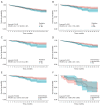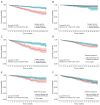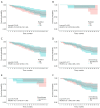Development and validation of survival prediction nomograms for patients with early-stage rectal cancer: a population-based study
- PMID: 40386280
- PMCID: PMC12079600
- DOI: 10.21037/tcr-24-1888
Development and validation of survival prediction nomograms for patients with early-stage rectal cancer: a population-based study
Abstract
Background: The incidence of colorectal cancer (CRC) has been rising in recent years, with a concurrent increase in early-stage rectal cancer (ESRC) cases. This study aimed to investigate risk factors and developed nomograms to predict overall survival (OS) and cancer-specific survival (CSS) in ESRC patients in order to improve clinical outcomes across diverse patient subgroups.
Methods: Risk factors were investigated in ESRC patients by analyzing data from the Surveillance, Epidemiology, and End Results (SEER) database. We developed and validated nomograms to predict OS and CSS after dividing patients into two risk groups. Then we assessed the potential benefits of various therapies across subgroups after propensity score-matching (PSM).
Results: T stage, tumor grade, age, carcinoembryonic antigen (CEA) levels, tumor size, and surgical options emerged as independent risk factors through univariate and multivariate Cox regression analyses, contributing to the OS nomogram; while for CSS, the identified risk factors were tumor grade, age, elevated CEA levels and surgical options. The Concordance-index of the nomogram surpassed that of the American Joint Committee on Cancer (AJCC) 7th staging system, with values of 0.69 (C-index, 0.64-0.74) in the training set and 0.65 (C-index, 0.62-0.68) in the testing set. The receiver operating characteristic (ROC) analysis revealed area under the curve (AUC) values of 0.70, 0.70, and 0.67 for 1-, 3-, and 5-year OS in the development cohort, with comparable results in the validation cohort. Calibration plots demonstrated strong alignment between predicted and observed outcomes. Decision curve analysis (DCA) confirmed the nomogram's superior clinical utility relative to the AJCC 7th staging system, with similar findings for CSS. Kaplan-Meier curves illustrated significant differences in OS and CSS between low- and high-risk groups. Notably, radiation and chemotherapy conferred no benefit, while low-risk patients, especially younger individuals, may benefit from local resection.
Conclusions: This study presents a comprehensive prognostic analysis of patients with ESRC and developed predictive nomograms for OS and CSS. Subgroup analyses highlight the potential benefits of local resection in younger patients with low risk.
Keywords: Early-stage rectal cancer (ESRC); chemotherapy; local resection; prognosis; radiation.
Copyright © 2025 AME Publishing Company. All rights reserved.
Conflict of interest statement
Conflicts of Interest: All authors have completed the ICMJE uniform disclosure form (available at https://tcr.amegroups.com/article/view/10.21037/tcr-24-1888/coif). The authors have no conflicts of interest to declare.
Figures






Similar articles
-
Development and validation of predictive nomograms for survival in early-onset colon cancer patients with II-III stage across various tumor sites.Transl Cancer Res. 2025 Apr 30;14(4):2233-2249. doi: 10.21037/tcr-2024-2290. Epub 2025 Apr 27. Transl Cancer Res. 2025. PMID: 40386271 Free PMC article.
-
Development and validation of nomograms for predicting survival of locally advanced rectosigmoid junction cancer patients: a SEER database analysis.Transl Cancer Res. 2025 May 30;14(5):2808-2821. doi: 10.21037/tcr-24-1810. Epub 2025 May 27. Transl Cancer Res. 2025. PMID: 40530120 Free PMC article.
-
Development and validation of cancer-specific survival prediction nomogram for patients with T4 stage colon cancer after surgical resection: a population-based study.Int J Colorectal Dis. 2025 Mar 18;40(1):72. doi: 10.1007/s00384-025-04856-3. Int J Colorectal Dis. 2025. PMID: 40102264 Free PMC article.
-
Development and validation of prognostic nomograms for early-onset colon cancer in different tumor locations: a population-based study.BMC Gastroenterol. 2023 Oct 21;23(1):362. doi: 10.1186/s12876-023-02991-1. BMC Gastroenterol. 2023. PMID: 37865754 Free PMC article.
-
A nomogram to predict postoperative overall and cancer specific survival in patients with primary parotid squamous cell carcinoma: a population based study.Sci Rep. 2025 Feb 25;15(1):6774. doi: 10.1038/s41598-025-90480-8. Sci Rep. 2025. PMID: 40000793 Free PMC article.
References
-
- Hirai Y, Toyoshima N, Saito Y. Endoscopic Resection for Colorectal Tumors. Digestion 2025;106:115-21. - PubMed
LinkOut - more resources
Full Text Sources
Miscellaneous
